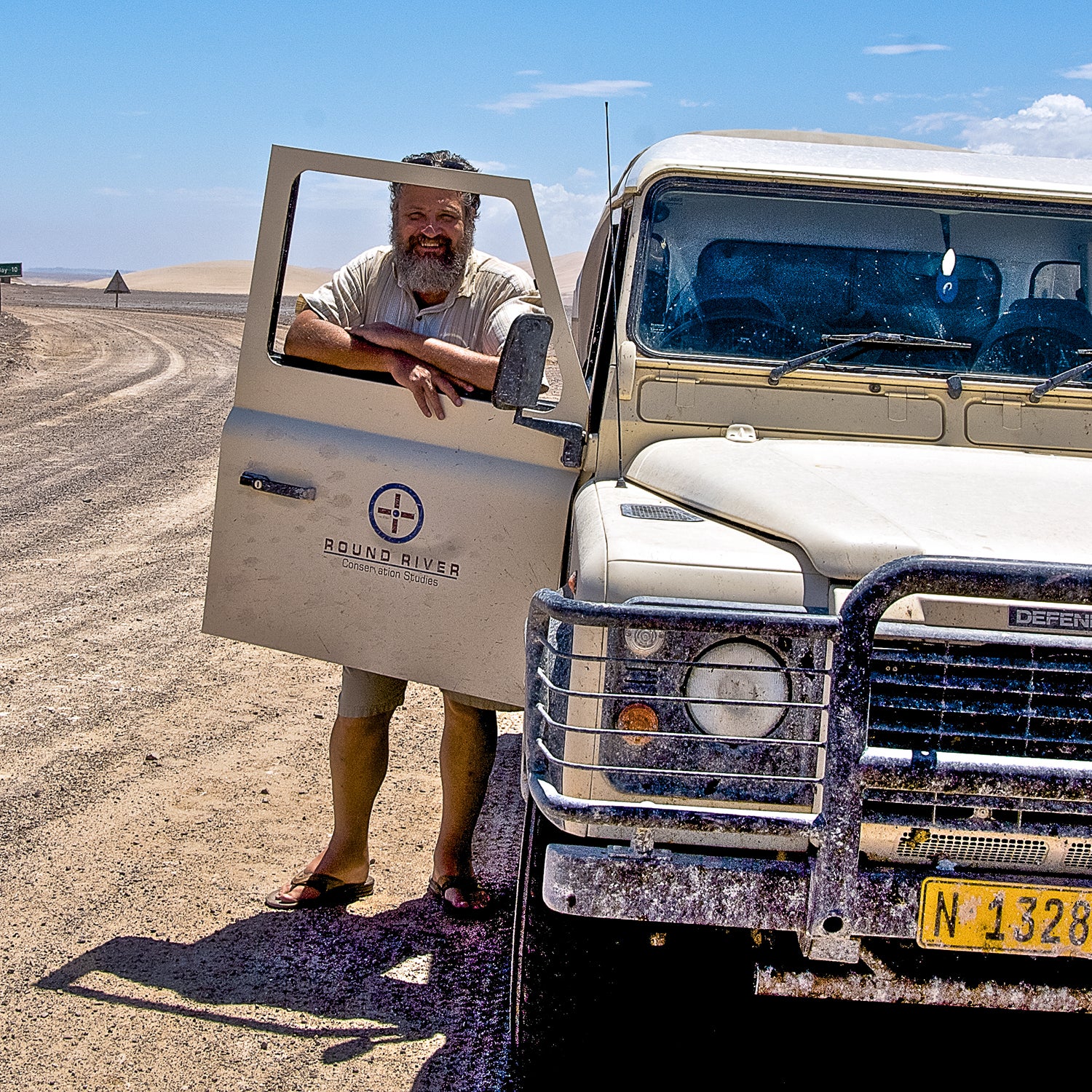Dennis Sizemore is limping, shuffling his swollen left ankle through the dusty streets of Maun, Botswana, the╠řgateway city to the wildlife-rich Okavango Delta. Over his╠řlong conservation career, itÔÇÖs hardly the 67-year-oldÔÇÖs first injury. The former college linebacker has been slapped into a tree by a grizzly, breaking ribs and his left arm;╠řtraded gunfire with poachers in New Mexico;╠řand been╠řmedevaced╠řto Anchorage, Alaska, when that same hapless arm was nearly severed by the prop of a floatplane.╠ř
Considering the brutality of injuries past, this latest wound feels a little ironic. ItÔÇÖs mid-September 2019, and╠řSizemore has ruptured his Achilles tendon╠řstepping into a Maun hotel conference room for a meeting with the leaders of the Okavango safari industry. But╠řas he well knows, the most significant conservation work often gets done in conference rooms.
Sizemore is the director of , a university ecology program that offers students╠řsemesters in places like Namibia, Chile, Mongolia, and British Columbia. At the same time, the organization has secured protection for╠ř19 million acres worldwide, some of the largest blocks of biodiverse wilderness on earth, with a full-time staff of just eight. Round River╠řworks to empower indigenous people to set and reach their own environmental stewardship╠řgoals.╠řIn a conservation movement historically╠řcharacterized by white people telling indigenous people what to do with their land, the organization stands out for listening instead.╠ř
ÔÇťRound River does the kind of work that is focused on the community, which isnÔÇÖt as common as you might think,ÔÇŁ says Rhea Suh, former president of the Natural Resources Defense Council and an assistant╠řsecretary of the Interior Department under President Obama. ÔÇťThat means taking local economies into account. Finding ways to do conservation without evaporating residentsÔÇÖ╠řeconomic opportunities is the hardest work, but itÔÇÖs the most durable.ÔÇŁ
Tourism is BotswanaÔÇÖs second-largest industry after diamond mining, drawing people from around the globe╠řto experience thriving populations of lions, leopards,╠ř▓╣▓ď╗ň zebras. The country is home to some 130,000 elephantsÔÇönearly half the worldÔÇÖs remaining wild populationÔÇöup from 80,000 in 1996. Trophy hunting was banned in Botswana in 2014, but the increase is due in╠řlarge part to the fact that╠řthe animals have been for years to avoid poachers in neighboring countries.
That population boom, however,╠řhas led to human conflicts. Between August 2018 and August 2019, elephants killed 17 people in Botswana, many of them defending their crops. In addition, conservationists link the conflicts to an uptick in poaching, as farmers╠řvictimized by elephants have fewer qualms about helping foreign ivory poachers.╠ř
In the villages of Sankoyo and Mababe, just outside the Okavango Delta, itÔÇÖs easy to see the effects of the increased elephant populationÔÇöfields lie fallow, fruit trees are broken and bare, and elephants have trampled nearly every fence. Villagers there say they havenÔÇÖt bothered to farm since 2013.╠ř
ÔÇťMy house used to be surrounded by crops,ÔÇŁ says Igea Newa, 66, gesturing to dusty fields. ÔÇťNow we canÔÇÖt plant fruit trees or a garden. The elephants destroy them.ÔÇŁ╠ř
Last spring╠řthe government announced that╠řtrophy hunting would once again be allowed in an effort to cull elephant numbers.╠řNewa welcomed the change, but the decision has been controversial, , a drop in safari bookings (something╠řthat has been exacerbated by the current coronavirus pandemic), and╠řanger over how the 158 licenses were issued and that .╠ř
In a conservation movement historically characterized by white people telling indigenous people what to do with their land, Round River stands out for listening instead.╠ř
Some conservation groups, including Round RiverÔÇÖs local partner, Botswana Predator Conservation Trust, are╠ř, focusing on trophy huntingÔÇÖs capacity to generate employment and revenue for wildlife programs.╠řStill, Round River hopes to keep the bloodshed from ramping up by funding solutions to human-wildlife conflicts that donÔÇÖt involve killingÔÇönot just of elephants╠řbut also lions and other predators. Think: renting watering holes from ranchers for migrating zebras or creating a market for higher-value╠řÔÇťwildlife-friendly beef,ÔÇŁ which incentivizes farmers to bring their cows in at night so they arenÔÇÖt killed by predators.╠ř
Communities will choose their own╠řtactics, but each requires money, which is the purpose of SizemoreÔÇÖs╠řtrip to MaunÔÇöhis 40th to Botswana. He has arranged a meeting of the major players in the Okavango safari industry in hopes theyÔÇÖll agree to ante into a fund to pay for his plan. Round River would augment the envisioned $50 million fund with donations from environmental foundations. ÔÇťThe problem isnÔÇÖt raising the money,ÔÇŁ says Sizemore, limping into the meeting. ÔÇťItÔÇÖs getting a bunch of competitors to agree to work together.ÔÇŁ╠ř
Sizemore has raised millions for conservation in his career, but he started Round River with just a bottle of George Dickel whisky╠ř▓╣▓ď╗ň a few pounds of backstrap from a pronghorn his father had╠řshot. Those were the gifts he bore in 1991 when he knocked on the door of grizzly bear activist Doug Peacock.
A former research assistant with the New Mexico Department of Game and Fish╠ř▓╣▓ď╗ň biologist at the University of Montana, Sizemore wanted his work to have bigger effects. He figured that Peacock, with his ties to╠řthe activist edge of the conservation movement, could help.╠ř
Over the bourbon and backstrap, the pair launched Round River Conservation that same evening, naming it after a seminal essay on ecosystem protections. Their first donors were Patagonia founder Yvon Chouinard and the late ecological philanthropist Doug Tompkins, whose landscape-scale restoration project in Chile╠řforeshadowed the groupÔÇÖs preference to preserve large blocks of habitat. In those chunks, points out Peacock, ÔÇťyou always find indigenous people living,ÔÇŁ a fact Round River has relied on to make its╠řmark on the conservation world.╠ř
Sizemore has had particular success in British Columbia:╠řRound River helped save five million acres of old growth in the Great Bear Rainforest, and in the╠řTaku Watershed, after a 14-year fight, eight million acres were spared. A key in both cases was SizemoreÔÇÖs deployment of ÔÇťtraditional ecological knowledge,ÔÇŁ a╠řtechnique that augments field surveys with localsÔÇÖ╠řgenerations-long experience of hunting and gathering on the╠řland.╠řThe process had╠řthe side effect of galvanizing local╠řsupport among people tired of being╠řdisenfranchised. ÔÇťBeing involved╠řgot people to open up and get very organized with protecting our lands,ÔÇŁ says John Ward, a Taku River Tlingit First Nation elder.╠ř
Another key strategy to Round RiverÔÇÖs outsize╠řresults are its student groups. Each semester, fresh cadres continue long-term ecological studies in the regions where the organization works, helping underpin the conservation objectives╠řbut also allowing it to maintain an active presence in certain╠řcommunities for years on end. That can be a significant contrast from the more sporadic, and jaded, appearance╠řof some larger conservation groups. ÔÇťPeople╠řlike having the students around,ÔÇŁ says Sizemore. ÔÇťTheir optimism and energy make them great ambassadors.ÔÇŁ
In the Maun conference room, Sizemore is at his ambassadorial best. He has his swollen leg╠řpropped on a chair beside him and speaks softly, letting others drive the meeting as much as possible. Not always so benevolent,╠řSizemoreÔÇÖs grizzly-like tenacity is legendary. He is, says author and close friend Terry Tempest Williams, a man of ÔÇťbig ideas, big results, big heart, big shadows.ÔÇŁ Sizemore likes to tell the story of challenging one former Round River staffer to a fistfight during a meeting with Namibian government officials╠ř▓╣▓ď╗ň has had fallouts with allies during the push to designate Bears Ears as a National Monument.╠ř
But no fistfights are necessary in Maun. In fact, Sizemore doesnÔÇÖt have to say much because heÔÇÖs brought along a ringer. Ross McMillan, the recently retired CEO of the environmental nonprofit╠ř, tells the safari-industry stakeholders the story of the $120 million Coast Funds, which he helped engineer. Born╠řfrom an agreement between 26 separate First Nations tribes in the Great Bear Rainforest and the Canadian government, the fund is much more complex than whatÔÇÖs being proposed in the Maun meeting, but it brightly illustrates whatÔÇÖs possible. Logging in that rainforest, the source of years of bitter political protests, would have yielded just a handful of local jobs for First Nations people, says McMillan. Instead, supported by the fund, 1,033 jobs have been created in sustainable logging, aquaculture, and tourism since 2009.╠ř
The dozen safari-industry representatives are sitting up straight and peppering McMillan with questions. Everyone is essentially convinced, and the remaining day and a half consists of people getting used to the idea. Afterward,╠řJennifer Lalley, cofounder of the safari operator Natural Selection, says that while some companies like hers already support conservation work, collective projects are usually more successful. ÔÇťAny collaborative efforts in conservation or poverty alleviation have the potential of achieving a much greater impact than individual efforts,ÔÇŁ she says.╠ř
Anderson Kambimba, a staff member of the Botswana Democratic Party, agrees that such a fund would help both his Okavango community and the animals╠řliving nearby. ÔÇťWildlife in and around my community are unfortunately viewed as government property and responsibility,ÔÇŁ he says. ÔÇťThis results in wildlife and habitat receiving negative attention every time government is perceived in a bad light.ÔÇŁ A community conservation fund, he says, would bring a sense of ownership and accountability. ÔÇťWhen people connect economic benefit to wildlife and habitat conservation, their commitment to protecting it rises. The community will fight wildfires, discourage and guard against poaching, police harmful waste-disposal practices, and so on.ÔÇŁ
Sizemore has raised millions for conservation in his career, but he started Round River with just a bottle of George Dickel whisky and a few pounds of backstrap from a pronghorn heÔÇÖd hunted.
After the meeting, Sizemore meets a group of Round River students for dinner at a caf├ę. Despite the meetingÔÇÖs success, and in what is meant to be a pep talk for the students, he canÔÇÖt help but veer into melancholy.╠ř
YouÔÇÖll be doing important work,╠řhe tells the eight undergrads. ÔÇťBut it can be awfully hard sometimes. One has to learn to embrace loss.ÔÇŁ His voice cracks, and a tear runs from behind his yellow-tinted eyeglasses. He apologizes and blames the emotion on the four Advil he took and the double gin and tonic heÔÇÖs drinking, but itÔÇÖs obvious that heÔÇÖs a man whose emotions are always swirling close to the surface.
Later, Sizemore mentions a quote of LeopoldÔÇÖs: ÔÇťOne of the penalties of an ecological education is that you live alone in a world of wounds.ÔÇŁ╠ř
The students help push him on, even as he eclipses the age when most would throw in the towel.╠řÔÇťI try to absorb as much of their youthful exuberance as I can,ÔÇŁ he says, acknowledging a duty to those who continue to show up looking for tools to heal a world that, even in their brief lifetimes, has been accumulating even more wounds.


